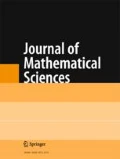In the present paper, a few steps are undertaken towards the description of the “qubit–qutrit” pair – a quantum bipartite system composed of two- and three-level subsystems. Calculations of the Molien functions and Poincaré series for the qubit-qubit and qubit-qutrit “local unitary invariants” are outlined and compared with the known results. The requirement of the positive semi-definiteness of the density operator is formulated explicitly as a set of inequalities in five Casimir invariants of the enveloping algebra \( \mathfrak{su}\)(6). Bibliography: 26 titles.
Similar content being viewed by others
References
M. A. Nielsen and I. L. Chuang, Quantum Computation and Quantum Information, Cambridge Univ. Press, Cambridge (2000).
V. Vedral, Introduction to Quantum Information Science, Oxford Univ. Press, New York (2006).
H. Weyl, The Classical Groups: Their Invariants and Representations, Princeton Univ. Press, Princeton (1939).
V. L. Popov and E. B. Vinberg, “Invariant theory,” in: Algebraic Geometry IV, Encycl. Math. Sci.. Vol, 55, Springer-Verlag, Berlin (1994), pp. 123–273.
N. Linden and S. Popescu, “On multi-particle entanglement,” Fortschr. Phys., 46, 567–578 (1998).
M. Grassl, M. Rötteler, and T. Beth, “Computing local invariants of qubit systems,” Phys. Rev. A, 58, 1833–1859 (1998).
R. C. King, T. A. Welsh, and P. D. Jarvis, “The mixed two-qubit system and the structure of its ring of local invariants,” J. Phys, A, 40, 10083–10108 (2007).
V. Gerdt, Yu. Palii, and A. Khvedelidze, “On the ring of local polynomial invariants for a pair of entangled qubits,” J. Math. Sci., 168, 368–378 (2010).
M. Kus and K. Źyczkowski, “Geometry of entangled states,” Phys. Rev. A, 63, 032307 (2001).
I. Bengtsson and K. Źyczkowski, Geometry of Quantum States, An Introduction to Quantum Entanglement, Cambridge Univ. Press, Cambridge (2006).
F. T. Hioe and J. H. Eberly, “N-level coherence vector and higher conservation laws in quantum optics and quantum mechanics,” Phys. Rev. Lett., 47, 838–841 (1981).
N. Jacobson, Lie Algebras, Wiley-Interscience, New-York-London (1962).
I. M. Gelfand, “The center of an infinitesimal group ring,” Mat. Sbornik N.S., 26, No. 1, 103–112 (1950).
D. P. Zhelobenko, Compact Lie Groups and Their Representations, Transl. Math. Monographs, Vol. 40, Amer. Math. Soc., Providence, Rhode Island (1978).
L. C. Biedenharn. “On the representations of the semisimple Lie groups, The explicit construction of invariants for the uniniodular unitary group in N dimensions,” J. Math. Phys., 4, 436–445 (1963).
R. H. Dalitz, “Constraints on the statistical tensor for low-spin particles produced in strong interaction processes,” Nucl. Phys., 87, 89–99 (1966).
P. Minnaert, “Spin-density analysis, Positivity conditions and Eberhard-Good theorem,” Phys. Rev., 151, 1306–1318 (1966).
S. M. Deen, P. K. Kabir, and G. Karl, “Positivity constraints on density matrices,” Phys. Rec. D, 4, 1662–1666 (1971).
G. Kimura, “The Bloch vector for N-level systems,” Phys. Lett. A, 314, 339–349 (2003).
M. S. Byrd and N. Khaneja, “Characterization of the positivity of the density matrix in terms of the coherence vector representation,” Phys. Rev. A, 68, 062322 (2003).
V. Gerdt, A. Khvedelidze, and Yu. Palii, “Constraints on SU(2) ⊗ SU(2) invariant polynomials for a pair of entangled qubits,” Yad. Fiz., 74, No. 6, 919–925 (2011).
M. Hochster and J. Roberts, “Rings of invariants of reductive groups acting on regular rings are Cohen-Macaulay,” Adv. Math., 13, 125–175 (1974).
D. Djokovic, “Poincaré series for local unitary invariants of mixed states of the qubit-qutrit system,” arXiv:quant-ph/0605018v1 (2006).
A. J. Macfarlane and H. Pfeiffer, “On characteristic equations, trace identities and Casimir operators of simple Lie algebras,” J. Math. Phys., 41, 3192–3225 (2000),
V. I. Ogievetsky and I. V. Polubarinov, “Eightfold-way formalism in SU(3) and 10- and 27-plets,” Yad. Fiz., 4, 853–861 (1965).
A. P. Bukhvostov, “The algebra of 3 × 3 matrices in 8-dimensional vector representation,”’ Preprint of St. Petersburg Nuclear Physics Institute, INP-1821/1822 (1992).
Author information
Authors and Affiliations
Corresponding author
Additional information
Published in Zapiski Nauchnykh Seminarov POMI, Vol. 387, 2011, pp. 102–121.
Rights and permissions
About this article
Cite this article
Gerdt, V., Mladenov, D., Palii, Y. et al. SU(6) Casimir invariants and SU(2) ⊗ SU(3) scalars for a mixed qubit-qutrit state. J Math Sci 179, 690–701 (2011). https://doi.org/10.1007/s10958-011-0619-9
Received:
Published:
Issue Date:
DOI: https://doi.org/10.1007/s10958-011-0619-9



